Story by Josh Sanburn
Introduction by Richard Lacayo
![]()
For years after the 9/11 attacks, nearly all the activity at Ground Zero was downward—digging through the piles of debris, excavating a vast pit to restore the ruined transit lines, preparing the foundations for the new buildings that would emerge there. Even the memorial that opened in 2011 was an exercise in the poetics of descent—two vast cubic voids, each with water cascading down all four sides, carrying grief to some underground resting place.
The memorial has turned out to be a lovely thing, but what the site still needed was something that climbed, something that spoke to the idea that emotional burdens might not only be lowered into the ground but also released into the air. Now we have it: One World Trade Center, the glass-and-steel exclamation point, all 1,776 feet of it, is nearing completion close to where the Twin Towers once stood. No doubt the new building’s official dedication will open the way to a necessary debate over its merits as architecture and urbanism, its turbulent design history and the compromises made over the long years it took to get the thing built. But in one important respect, One World Trade Center has already succeeded. It has reclaimed the sky. And this is the view from there.
![]()
Photograph by Jonathan D. Woods and Michael Franz for TIME; Stitching: Gavin D. Farrell; Compositing: Meghan P. Farrell; Color: Claudio Palmisano/10b
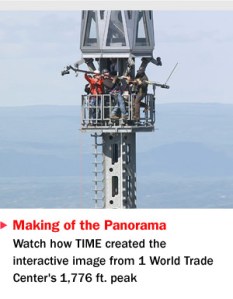 Kevin Murphy says he has the best office in America, and I’m not arguing, not here, 1,250 ft. above New York City, from a vantage point so high that the Statue of Liberty looks like a toy and the Brooklyn Bridge seems so small and close, we could reach down and scoop it out of the East River. Not when lower Manhattan, once as quiet as a Quaker meeting, hums like a well-oiled engine more than 100 stories below our feet.
Kevin Murphy says he has the best office in America, and I’m not arguing, not here, 1,250 ft. above New York City, from a vantage point so high that the Statue of Liberty looks like a toy and the Brooklyn Bridge seems so small and close, we could reach down and scoop it out of the East River. Not when lower Manhattan, once as quiet as a Quaker meeting, hums like a well-oiled engine more than 100 stories below our feet.
Murphy works at the top of a building that is so much more than four walls and a roof: One World Trade Center is a statement of hope and defiance written in steel and glass, a marvel of persistence, a miracle of logistics. It is the tangible expression of a people forced quite literally to dig deep for new footings after an unspeakable blow, and there were many dark moments when it was hard to believe that anyone would stand here again.
“I’m like everybody else, looking at this place in amazement,” says Murphy, who leads the team of ironworkers that has pieced together the skeleton of this skyscraper. “This is going to define New York.”
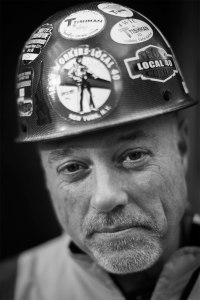
For the past 12 years, it sometimes seemed as if New York’s defining feature would be a 16-acre gash that wouldn’t heal. Tangled in political power struggles and red tape, the site cleared by the terrorist attacks on Sept. 11, 2001, long ago lost any luster of post-9/11 unity. Nine governors, two mayors, multiple architects, a headstrong developer, thousands of victims’ families and tens of thousands of neighborhood residents fought over this tiny patch of real estate as if every clod were holy and every windswept acre held the fate of the Western world.
Progress came in fits and starts. A forced marriage between two architects with divergent ideas for the building — the site’s master planner, Daniel Libeskind, and David Childs, 1 WTC’s lead architect — slowed the pace. Three years passed after 9/11 before the symbolic cornerstone signaling the beginning of construction was laid. Two more went by before a design for the memorial was finalized. All the while, 1 WTC, the only building on the site that would reach the heights of the Twin Towers, was little more than a gaping hole in the ground. As the years passed and the delays mounted, it was impossible not to wonder, What’s taking so long? And worse, Have we lost the capacity to rebuild?
The answer, in part, was just beneath the surface: 10,000 workers attempting one of the most complicated construction projects ever in one of the most densely populated places on the planet. The design, almost entirely Childs’, called for a 104-story tower that includes a bomb-resistant 20-story base set on 70-ton shafts of steel and pilings sunk some 200 ft. into the earth. This unseen subterranean structure would support 48,000 tons of steel — the equivalent of 22,500 full-size cars — and almost 13,000 exterior glass panels sheathing a concrete core crowned by a 408-ft. spire whose beacon would glow at the symbolic height of 1,776 ft. (eclipsing Chicago’s Willis Tower as the tallest building in the western hemisphere). The structure includes enough concrete to lay a sidewalk from Manhattan to Chicago. And that was just one part of a 16-acre project that was the equivalent of building five Empire State Buildings on a plot of land the size of a suburban shopping mall — while tens of thousands of commuters traveled under the work zone each day.
But the long wait was also the result of a nearly impossible mandate: One World Trade Center needed to be a public response to 9/11 while providing valuable commercial real estate for its private owners, to be open to its neighbors yet safe for its occupants. It needed to acknowledge the tragedy from which it was born while serving as a triumphant affirmation of the nation’s resilience in the face of it.
“It was meant to be all things to all people,” says Christopher Ward, who helped manage the rebuilding as executive director of the Port Authority of New York and New Jersey. “It was going to answer every question that it raised. Was it an answer to the terrorists? Was the market back? Was New York going to be strong? That’s what was really holding up progress.”
Almost 13 years later, many of those questions remain unanswered. The market has roared and slumbered, though financial firms have returned to lower Manhattan and the surrounding neighborhoods are buzzing with energy. The nation remains on perpetual terrorism alert, though this fact no longer hampers us from going about our daily lives. But at least one answer is known. While 1 WTC may not be all things to all people, its completion signals that America’s brawny, soaring ambition — the drive that sent pioneers west, launched rockets to the moon and led us to build steel-and-glass towers that pierced the clouds — is intact. Reaching 1,776 ft. has ensured it.
Getting there, says Childs, has been “the most complicated manufacturing event which is never to be repeated. I mean, it’s a onetime event.”
One World Trade Center shares its 16-acre site with other massive projects built at more or less the same time: the transportation hub, which links a series of underground trains that need to operate as work goes on around and above them; a subterranean vehicle-security center, atop which a park and church will eventually sit; the 9/11 Memorial, designed to be the site’s central gathering point while doubling as the roof of the vast belowground 9/11 Museum; and three other large office buildings.
In response to its crowded neighborhood, Childs believed 1 WTC needed to be distinctive and concise — as if the site’s complexity called for the opposite in the design of its landmark building. “Ask an 8-year-old who spent her spring vacation in Washington to draw something she remembers,” he says. “She can get the Washington Monument dead right. There’s something powerful about that, at the heart of the city, organizing it all.”
The building’s exterior is made up of eight isosceles triangles, and as it rises, it morphs from a square into an octagon and then into another square, turned 45 degrees from the first. It gives the appearance of twisting, with the glass triangles meeting in the sky. “This has a clear, logical, geometrical ending to it all,” Childs says.
But before anyone could think of reaching that ending, it was necessary to build down into the thick bedrock that underlies Manhattan to plant the structures that would support the 3.5 million-sq.-ft. tower. Construction began on April 27, 2006 — four years and 228 days after the 9/11 attacks. The early work was time-consuming and labor-intensive. One challenge was to build around the PATH train, a major artery linking New York to New Jersey, without disturbing the infrastructure. The solution, requiring 18 months of planning, was to proceed by hand, without heavy machinery. “You had people down there with picks and shovels and mini-excavators, maybe digging a foot a night,” says Dan Tishman, chairman of Tishman Construction, which manages construction at the site. “It was a surgical approach.”

Throughout 2006, workers beat and battered the earth, using precisely calibrated explosives to make room for 27 steel columns and a series of massive concrete footings that reached more than 200 ft. below street level. As they dug into the ground, the crew often came across reminders of why they were there.
“Literally the first thing — and I don’t exaggerate by saying the first thing — we were digging and we found human remains that were missed,” recalls Steve Plate, the Port Authority’s director of construction for the site. The remains had been hidden for almost five years, packed inside buried sewer pipes by the force of the collapsing towers. Over the years, some workers found shoes. Others unearthed wallets. Medical examiners became a regular presence on the site, sifting through debris and isolating material that appeared to contain human DNA. In the early days of excavation, such grim discoveries happened almost daily.
Other findings were less somber. Timber, struck when workers were digging the foundation of the vehicle-security center, turned out to be an 18th century boat that had been encased in landfill when that part of lower Manhattan was developed in the 1800s. The Hudson River once flowed through the site, and the area that became the original World Trade Center had been a slip. Archaeologists couldn’t identify the ship’s origins, but they did find a clue to its provenance: a button from a British soldier’s Revolutionary War coat. Other discoveries included cattle bones from a 19th century slaughterhouse and a 40-ft. pothole about 110 ft. below sea level, which geologists determined was carved some 20,000 years ago by glaciers that had picked up shale and sandstone from the Palisades in what is now New Jersey. The ice-age terrain had to be filled in with concrete, covered or blasted away to ensure a level foundation for 4 World Trade Center.
As the crew toiled underground, 805 tons of steel was being produced at a Luxembourg plant known for creating the heaviest I-beams in the world. Once they reached the U.S., the 30-to-56-ft. slabs were strengthened with steel plates that increased their weight to 70 tons each. By the end of 2007, workers had placed a ring of steel columns around the perimeter of 1 WTC. By then, the massive concrete footings and foundation were nearly done. But to passersby on the street, the site appeared unchanged.
“The thing that most frustrated me in the early years was when people would say, ‘They’re not doing anything,’” says Marc Becker, Tishman’s deputy general superintendent. “No one knew the magnitude of the below-grade structure.”
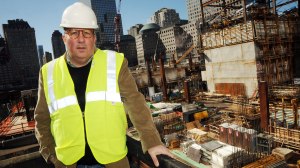
Below street level sits a formidable building in its own right. The 500,000-sq.-ft. structure supporting 1 WTC is one-third the size of the 1,046-ft. Chrysler Building, which gleams in Art Deco splendor over midtown Manhattan, and it required 45,000 cu. yd. of concrete. A typical New York City skyscraper takes about four years to build. Construction on 1 WTC had barely reached street level in that time span. “I was effectively handed a pit where the symbolic ramp to the bottom still existed,” says Ward, the former Port Authority director, who took over the agency in 2008. “There had been some foundation work, but it was largely visually unchanged for almost seven years.”
Weeks into his tenure, Ward said publicly what many close to the project had been grumbling about privately: the existing schedules and budgets were a fantasy. He said the real cost of 1 WTC, estimated at $1.5 billion when the design was unveiled in 2005, would be more like $3.1 billion. (The price tag was revised again, to $3.9 billion.) Ward dissolved a contract that failed to hold construction firms to a maximum price, and he extended the workday.
Ward’s changes eased the gridlock, and after two years of slouching toward street level, construction quickened. By 2009, workers had begun prepping the site for the 24 gigantic steel supercolumns that form the aboveground base of the tower. Building down was over. It was time to head up.
It takes an army of tradespeople to build a structure like 1 WTC — window installers, laborers, electricians, concrete pourers and carpenters among them. But it is the ironworkers who assemble the building with their gloved hands and sure feet, beam by beam, higher and higher, like a giant Tinkertoy.
The job tends to be a family affair. Many of the 1 WTC ironworkers have relatives who helped build the Twin Towers in the late 1960s and early ’70s. Murphy’s dad was one of them, a mentor to many of the ironworkers who erected 1 WTC. Crane operator Danny Dunn’s cousin helped put up the north tower’s antenna. An accident during construction on nearby 7 World Trade Center in the mid-1980s paralyzed the father of ironworker Michael O’Reilly.
Skyscraper construction is part brute strength, part delicate dance. It starts with a raising gang, which lifts a piece of steel from street level using cranes weighing upwards of 250 tons each. Signalmen guide the pieces toward connectors, who bolt them together while balancing on nearby beams. Dangling in the breeze, the steel can wobble and shake as the crew guides it into position. The trickiest fits sometimes require workers to lie down on adjacent beams, balancing far above the street, often on a slab less than a foot wide.
“Everything we do, everything we deal with, is heavy,” says O’Reilly. “The entire day is a struggle, and your body gets beat down. It’s like being in the NFL. Every muscle aches. When you get home, you’re shot.” It didn’t help that some ironworkers labored seven days a week, 10 hours a day, to maintain the pace of construction. Many worked 50 days straight.
As the steel structure neared the height of the former towers, the workers realized they were the first people to see that view since 9/11.
“We think about it,” Murphy says. “You can’t help but think about it. You see the families. You see the memorial. A lot of us worked at the cleanup. We’re constantly reminded of what we’re doing down here.”
In the midst of such dangerous labor, however, giving in to the emotional weight was too risky. Signalman John Collins says that if he thought about anything but the work, “I could kill them all. You got to worry about yourself and others. Mostly others.”
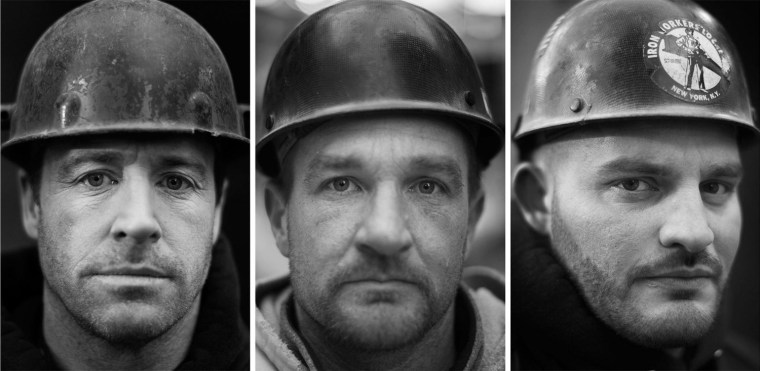
No workers have died on this job, but there have been injuries. Thomas Hickey, a steel connector whose father worked on the Twin Towers, tore a triceps and tendon in his right elbow after slamming his arm on some steel lugs. The damage landed the heavily tattooed amateur boxer a desk job and a new nickname: Iceman. His modified duties included fetching the 800 lb. of ice that filled the coolers of his fellow ironworkers each week during the summer. “You really put your life on the line every day,” he says. “It’s considered your sport.”
Other hazards stalked the site. The average glass panel in the exterior curtain walls of 1 WTC is 5 ft. wide and 13 ft. tall and weighs about 1,200 lb. “These gigantic panels act like a sail” in the swirling winds around the tower’s upper floors, says Robyn Ryan, project manager for Benson Industries, which installed the windows. “So you try to hold on to them with wire. But if the wind is too high, it’s just too dangerous.”
The seasons provided a different challenge. In the harsh sun of summer, the steel beams the ironworkers needed to sit on and maneuver by hand could reach temperatures that workers say were hot enough to singe their skin. Not that the cold was any better. “Winters really put a beating on you,” says Jorge Fernandez, an assistant foreman for the laborers who clean and maintain the site. “But we have a saying: ‘The heat’s in the tools.’ The more you work, the less cold you’ll be.”
Nothing could prepare the crew for the superstorm that gathered in the Atlantic Ocean in the fall of 2012. On Oct. 29, as Hurricane Sandy made a hard left turn toward the rising tower, the Port Authority scrambled to prevent the site from becoming Manhattan’s newest lake. When the storm hit, the massive holes that workers had spent years digging turned into street-level cataracts. “Niagara Falls is probably an exaggeration,” recalls Plate, the Port Authority’s director of construction. “But there was something of a rapids penetrating the site.”
When it was over, 125 million gal. of water had flooded the area. The damage came to $185 million, but it was almost entirely underground. The tower that thousands of workers had spent years building had survived. And in less than a week, construction was back on.
Just a few months before, 1 WTC had reached 104 stories. All that was left to do was put the crown on top.
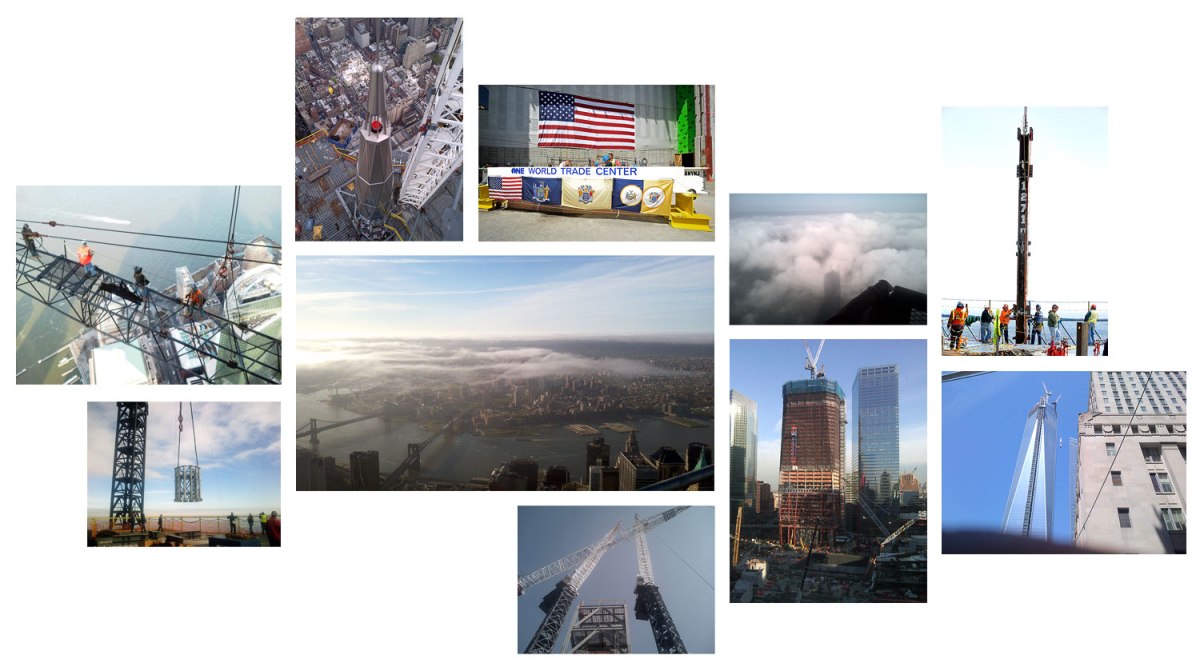
By the end of 2012, Jim Melvin’s commute had gotten tricky. At about 5 a.m., Melvin, a crane oiler, would leave home to catch the PATH train from New Jersey. Once he reached the site about 30 minutes later, he took the elevator to the 64th floor, then walked to another elevator bank that took him to the 90th. From there he rode a third elevator to the 104th, climbed the stairs to the roof, ascended a 20-ft. ladder and hiked nine more exterior sections to his crane. The trip from the ground to the top of 1 WTC took as long as the one from New Jersey to the site.
Melvin was part of the “north gang,” one of two groups that lifted 1 WTC’s final major installation: the 408-ft. spire. The first half of the spire, which was fabricated in 18 sections, left Quebec on barges in mid-November and arrived in lower Manhattan about a month later. The pieces, some weighing 67 tons, were then loaded onto a specially built 21-ft.-wide truck that inched through the empty city streets in the dead of night.
Melvin’s north gang soon began raising the spire piece by piece to the roof, where the elements were passed to the east gang’s connectors. Each piece was placed by hand. On May 10, both gangs cooperated in setting the final sections more than 1,700 ft. above the city. The beacon was draped with an American flag as the ironworkers guided it into place.
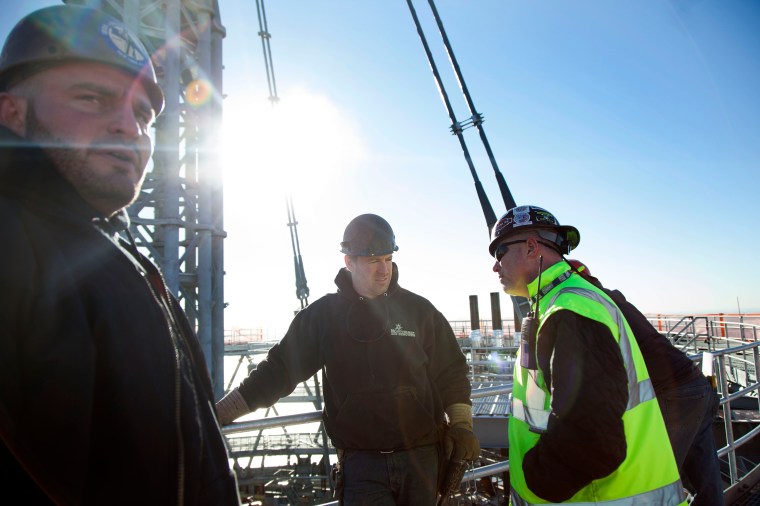
“The first thing I did the second it landed was go, ‘Aaah. Thank God,’” Murphy, the ironworkers’ supervisor, says. “You never really know if you’re going to have a problem. After that, I was overwhelmed like everybody else.”
Soon Murphy’s job will be done. The tenants of One World Trade Center are starting to build out their floors and will likely move in by the end of the year. The ranks of the ironworkers, carpenters and laborers who turned lower Manhattan’s most sacred pit into the world’s third tallest building are thinning by the day. Of a crew once 10,000 strong, only about 600 workers remain on the site.
For the past five years, Murphy has driven to America’s best office by way of the West Side Highway, the tower he was building emerging in the distance. On clear Manhattan mornings, the rising sun painted 1 WTC’s 12,774 mirror-like window panels in brilliant yellows and reds. When it snowed, flakes enveloped the tower. Murphy tried to capture each new exaltation in a cell-phone image snapped from his car’s sunroof.
“I can’t tell you how many pictures I take in the morning,” Murphy says. Now he’s not sure what he’ll do next. Maybe take some time off. Breathe again. But he’s certain nothing will top this. I’m not arguing, not as we watch airplanes gliding onto ribbons of tarmac at the region’s three major airports and not as the Empire State Building watches us watching it and the city looks up expectantly, finally, at something other than empty sky. “This is New York now,” Murphy says. And things look so much clearer from here.
An earlier version of this article misstated the title of Dan Tishman. He is chairman of Tishman Construction, not vice president.
